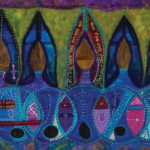Opinion: We Need a Digital-First Curriculum to Teach Modern Journalism
Cindy Royal, journalism professor at Texas State University, identifies three guiding principles for journalism schools attempting to conceptualize an entirely new curriculum around digital and data-driven communication.
By Cindy Royal, for PBS MediaShift
At the annual meeting of the Association for Education in Journalism and Mass Communication in Washington, D.C., earlier this month, one panel addressed adding programming skills to the curriculum: “Why All Your Students Must Be Programmers.”
The inevitable question was posed: What would you cut from existing offerings to make room for these new topics? Some were provocative in their responses, like NPR news application editor Brian Boyer’s declarations: “No print design. Done.” And, “Adobe products are dead to me.” Matt Waite of University of Nebraska said he gets around curriculum limitations by holding special office hours he calls “Maker Hours,” allowing interested students to hack on projects. But overall, few specific recommendations were offered as to how programming could best be integrated into existing curriculum.
It got me thinking about how many schools, including my own program at Texas State University, have approached digital in a piecemeal fashion — injecting digital topics into existing courses, creating a few electives, or in some cases, adding a single required course.
Related content on J-Source:
- Melanie Coulson is J-Source’s new education editor
- Opinion: J-schools should innovate by prioritizing research and discovery instead of waiting for industry to dictate its needs
- Students worry about future of University of Ottawa’s journalism program
I think there is a better route, another way to conceptualize an entirely new curriculum around Digital and Data-Driven Communication. And, in thinking about how this could be done, I’ve identified three guiding principles.
1. FLIP THE CURRICULUM
This is different than the recent concept of “flipping classes,” offering online lectures and outside work so that classroom time could be spent on discussion and exercises. While that may very well be a part of this approach, what I am proposing is curriculum in which digital is the foundation, and the basic skills of writing, reporting and editing are injected into digitally focused courses, as opposed to inserting a digital lesson or two into traditional classes.
Most programs have courses at their core that introduce basic skills, things like Media Writing, Media Law and Introduction to Mass Communication. Other programs also require courses in Media History or Mass Media and Society. I propose we flip and reconfigure these courses with a digital emphasis.
Introduction to Digital Media. This course would introduce students to the digital media environment, discussing the nature and scale of digital media and the role of social media to professional work and life. Students would emerge with an understanding of their personal brand and the beginnings of a digital portfolio that could follow them throughout their program of study. This class would also introduce new careers created by the digital age and the need to prepare for jobs that don’t exist yet. The course would begin to introduce writing, but writing would be done in the context of a content management system. In conjunction with learning AP style and the inverted pyramid, students would learn about linking and embedding visuals.
Multimedia/Mobile Writing and Reporting. These courses would be offered at different levels and focus on a variety of ways that digital can be integrated across mass communication fields. Students would learn writing, photography and multimedia editing skills together. They would learn how to report from the field, using a mobile phone or tablet and would gain judgment in which tools and platforms to use.
Digital Media Law. The digital media environment introduces new legal challenges and exacerbates existing ones. The important role of the press to democracy and the First Amendment would still be taught, but primarily in its context to digital media issues. The background of legislation and litigation will need to be connected to future implications in a digital environment, not just how they operated in the past.
History of Digital Media. You may think that history is the one class that shouldn’t be touched in a digital media curriculum. There is, however, a new history that is critical and relevant to our students’ understanding of the digital media environment — the history of technology. History classes should focus on the introduction of personal computers, the origination of the Internet and Web and how various sites and platforms — things like browsers, search engines, social media and mobile apps — have disrupted traditional media. This approach offers a mindset that encourages students to think innovatively about what could or should come next.
The Culture of Digital Media. The emphasis in this course would be on the culture of technology and how it has affected personal and professional interaction. Topics would include the open source and hacker ethos, innovation, entrepreneurship and social issues related to gender, race and other demographics associated with digital life.
Outside these contexts, there would be no dedicated writing, reporting or editing courses. These topics would be integrated and evaluated in the ways we approach digital media throughout the curriculum. Courses could be considered beyond the traditional semester or quarter system, potentially offering shorter terms or intensive weekend workshops.
2. NEW CONCENTRATIONS
[node:ad]I see concentrations with a skills emphasis, rather than focusing on a specific industry. Taking courses in one or more of these areas would provide students with a range of experiences that would qualify them for more and different positions.
Multimedia: This concentration would provide a visual focus in classes like digital photography, multimedia editing and design. Students could attain positions in traditional broadcast organizations or use their visual skills in organizations that want to include multimedia with their content. Training would be in traditional coverage, but also include character-driven narratives, multimedia packages and non-traditional storytelling. Graphic design would be approached with a significant focus on Web and mobile delivery.
Programming: At this point in the curriculum, students would know why programming and data are an important skill to storytelling. The courses leading up to this concentration would have introduced basic programming concepts and demonstrated their use in various projects. Courses would introduce more advanced programming concepts, Web development, data visualization, Web scraping, mobile development and advanced content management system customization. This concentration could be supported by collaborations with other departments or with local professionals or organizations, with the goal of ultimately co-opting these skills with a communications context.
Social Media: While every instructor would be expected to use relevant social media tools in the classroom, students with this concentration would be able to use advanced social media techniques in a variety of professional settings. They would be able to more specifically focus on engagement and advanced social media implementations, like the use of analytics and the creation of comprehensive social media campaigns. They would then be able to apply these techniques more specifically to courses that deal with traditional and non-traditional careers.
3. EXPERIENCE LEARNING
Students interested in working in traditional media fields would get the experience they need by working for student media and/or selecting a capstone course that addresses traditional fields in a digital context. Or they could select a course covering new careers in digital media with a focus on jobs in the tech industry and with startups. These courses would have a significant experience-learning component, allowing the students to work with clients or to cover university activities, local eventsor special projects.
The biggest challenge to this approach is in having educators with the training and knowledge to teach in and stay up-to-date with the digital environment. This may require different hiring qualifications, tenure and accreditation standards and career expectations. We must create incentives that will encourage faculty to move quickly in this direction.
This model is being proposed as a starting point for future conversations about radical curriculum reform. There are multiple ways that these recommendations could be implemented within a specific program: in lieu of traditional journalism and mass communication curriculum; introduced as a new major; developed as a new graduate curriculum; or proposed via a new academic center, allowing for interdisciplinary collaborations. It’s time that curriculum reflects the future of media, rather than its past, creating a comprehensive framework and courses that establish an innovative mindset amongst our students and ourselves.
Fascinated by a co-worker’s demonstration of HTML, Cindy Royal started her first website in 1996, a concert review site called onthatnote.com. This hobby inspired a career change focusing on the effects of the Internet on communication and media. After 13 years with NCR Corporation and Compaq Computer, she enrolled in the journalism program at The University of Texas at Austin, earning a Ph.D. in 2005. She now teaches Web design and leads digital media efforts as an associate professor at Texas State University. Royal is most proud of her students’ accomplishments, with many having gone on to careers at The New York Times, Digital First Media, Austin American-Statesman, Blackbaud, Spredfast, Homeaway, SXSW and more. She has been recognized with several teaching awards, including the Presidential Award for Excellence from Texas State University in 2013 and the Statesman’s Texas Social Media Award in 2010. Royal is a member of the 2013-2014 Knight Journalism Fellowship class at Stanford. More information on her background and activities can be found at cindyroyal.com.
This post orginally appeared on PBS' Mediashift blog. It is reposted on J-Source with permission by the author, and those at Mediashift.
Caption 1: Academics and professionals on ‘Why All Your Students Must Be Programmers’ at the AEJMC conference in Washington, D.C. Photo by Cindy Royal, Texas State University.
Caption 2: Students in Advanced Online Media at Texas State University learn Web development, responsive design, data visualization, Web scraping and content management system customization. Photo by Cindy Royal, Texas State University.
Caption 3: Digital media students would gain experience by covering university activities, local events (like the students above covering South By Southwest) or special projects. Photo by Cindy Royal, Texas State University.






